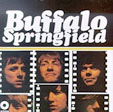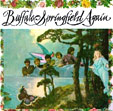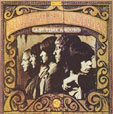
Buffalo Springfield (1966)Released a short time after the Beatles' Rubber Soul, Springfield's first album introduced listeners to two powerhouse songwriters (Stills & Neil Young) and one of the tightest rhythm sections in 60s pop (Bruce Palmer & Dewey Martin). What the record lacks in production finesse, it makes up for in spirited performances and material that crosses over so many genres--folk, rock, pop, and country. Nowadays Clancy Can't Even Sing introduces us to Young's quirky though always interesting chord and melody changes, shifting time signatures, and cryptic lyrics. But the cornerstone of the album has to be Stills' quintessential protest song, For What It's Worth--quintessential because it says in 2:40 what it took other singer/songwriters 12 verses to say. In four beautifully evocative stanzas, Stills paints a tense picture of conflict between youthful idealism and armored authority:
The interplay between the acoustic guitar, the tremolo harmonic chimes, and the fuzz l The set includes the country pop of Go and Say Goodbye, in which Stills admonishes a friend for not ending a relationship honestly and face-to-face:
A good deal of the rest of the material on their debut album is less focused, as if the band couldn't decide whether it wanted to appeal to teenagers or college students. At times the band sounds buoyant and bubbly, like the Lovin' Spoonful; other times, more like their progenitors, the Byrds. Buffalo Springfield Again (1967)This album might just as well have been titled Dueling Songwriters, as it demonstrates how the competition between Stills and Young forced each to push their limits of creativity and musical invention. No where is this more evident than in Stills' Bluebird--a jaw dropping tour de force of great songwriting and guitar playing, all the more impressive because it sounds nothing like anything else of its time. Bluebird begins and ends with lovely verses, the latter accentuated by Stills' front-porch banjo pickin'.
But Again is filled with other good material from both Stills and Young. Stills' Rock & Roll Woman continues with Bluebird's soundscape, only is arranged more for AM radio play with its "bah bah, bah-bah, bah-bah, bah-bah-bah" choral responses. Young is at his experimental best, offering two avant-garde epics, Broken Arrow and the sonically rich Expecting to Fly. By this release, it was becoming clear that Stephen Stills and Neil Young were to take their places alongside other great artists of the 60s and 70s--like Clapton, Hendrix, and Dylan--and would influence a whole generation of songwriters. I would also argue that though Young would reinvent himself through the decades like a cat with nine lives, Stills' guitar prowess, singing, and songwriting would burn much brighter over the next 5 years. Last Time Around (1968)Sadly not a strong final effort, Last Time Around does have a handful of exceptional tunes to
|
 ead fills provides the perfect counterpoint for Stills' gravely "old soul" vocal. It's an amazingly mature and sobering song penned by a musician barely 20 years old. As for the curious title, it goes like this: the band had presented several demos to the A&R people at the record label and nothing had impressed them, until Stills tossed one of them a tape demo of a protest song he'd written, saying "for what it's worth." The demo is what got them signed to a recording contract and the finished song became their only hit single, charting at #7.
ead fills provides the perfect counterpoint for Stills' gravely "old soul" vocal. It's an amazingly mature and sobering song penned by a musician barely 20 years old. As for the curious title, it goes like this: the band had presented several demos to the A&R people at the record label and nothing had impressed them, until Stills tossed one of them a tape demo of a protest song he'd written, saying "for what it's worth." The demo is what got them signed to a recording contract and the finished song became their only hit single, charting at #7. what falls between these bookends breaks completely with traditional song craft and is nothing short of a rock symphony of chiming acoustic guitars and long descending vocal cadences. Then there are the now famous guitar riffs where a grungy electric answers Stills' acoustic leads, which are played with so much intensity (and precision) that they get your adrenalin pumping. As future band mate Chris Hillman was to remark, "anyone who called Clapton God, never heard Stephen Stills play an acoustic guitar."
what falls between these bookends breaks completely with traditional song craft and is nothing short of a rock symphony of chiming acoustic guitars and long descending vocal cadences. Then there are the now famous guitar riffs where a grungy electric answers Stills' acoustic leads, which are played with so much intensity (and precision) that they get your adrenalin pumping. As future band mate Chris Hillman was to remark, "anyone who called Clapton God, never heard Stephen Stills play an acoustic guitar." recommend it. On the Way Home, with Richie Furay on lead vocal, is classic Neil Young, with its progressive country feel and unexpected, but always perfect chord changes. (The bass part on the tune is simply amazing. Listen as it moves in and around the melody and chords like a speed skater, locked to Dewey's kick drum.) Young's I am a Child is also outstanding, presenting a touching view of a father-son relationship. Stills' Pretty Girl Why offers a quiet swan song for Buffalo Springfield, with its sobering view of young soldier going off to war. The clean, smart production, by a young Jim Messina, presages the contribution he will make to Loggins & Messina a few years down the road.
recommend it. On the Way Home, with Richie Furay on lead vocal, is classic Neil Young, with its progressive country feel and unexpected, but always perfect chord changes. (The bass part on the tune is simply amazing. Listen as it moves in and around the melody and chords like a speed skater, locked to Dewey's kick drum.) Young's I am a Child is also outstanding, presenting a touching view of a father-son relationship. Stills' Pretty Girl Why offers a quiet swan song for Buffalo Springfield, with its sobering view of young soldier going off to war. The clean, smart production, by a young Jim Messina, presages the contribution he will make to Loggins & Messina a few years down the road.